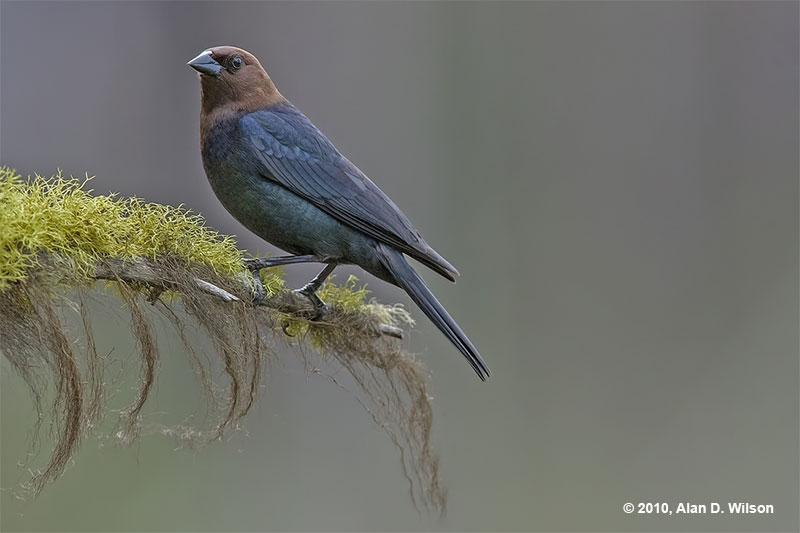
Blackbirds are some of the most common and familiar birds in North America. They can also have plumage with beautiful orange and yellow colors!
Grackles, Brewer’s Blackbirds, and cowbirds are blackbird species but so are gorgeous orioles and lovely meadowlarks.
Do you know how many blackbird species live in the USA? Can you identify all of them? See this article to learn how to identify these handsome and intriguing birds, and where you can see them!
On this page
Blackbirds in the U.S.
Go birding nearly anywhere in the USA, and you’ll see a blackbird or two. Although these fun birds don’t occur in Hawaii, a couple of blackbird species do live in Alaska, and others are common birds in many other parts of Canada and the USA.
In the USA, 27 species of blackbirds have occurred! Five of those are rare vagrants or introduced species but most are fairly common. All of them belong to the Icteridae family.
Several blackbird species are also short-distance migrants, but the Bobolink and a few of the orioles migrate to Central and South America.
We can find blackbirds in marshes and other open habitats, although Rusty Blackbirds and some orioles also live in forests. Read on to learn all about the most common blackbird species in the USA!
Yellow-headed Blackbird
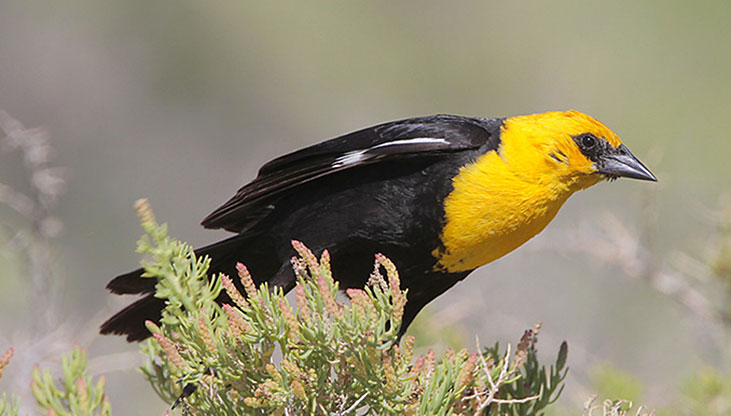
Scientific name: Xanthocephalus xanthocephalus
Size: 9.5 inches
Habitat: Freshwater marshes and open farm fields.
Yellow-headed Blackbirds are fair-sized blackbirds with sharp black beaks and yellow on their heads and chest. Males have bright yellow with a small black mask and a white wing patch while females are dark brown with dull yellow on their heads and chest.
These striking blackbirds are common in open freshwater marshes, mostly in western North America. Yellow-headed Blackbirds often flock together as they pick bugs and grain off the ground and from low vegetation in marshes and open farm fields. This species is pretty easy to see, especially when males sing their loud and crazy song.
They almost sound like they are being strangled!
Tricolored Blackbird
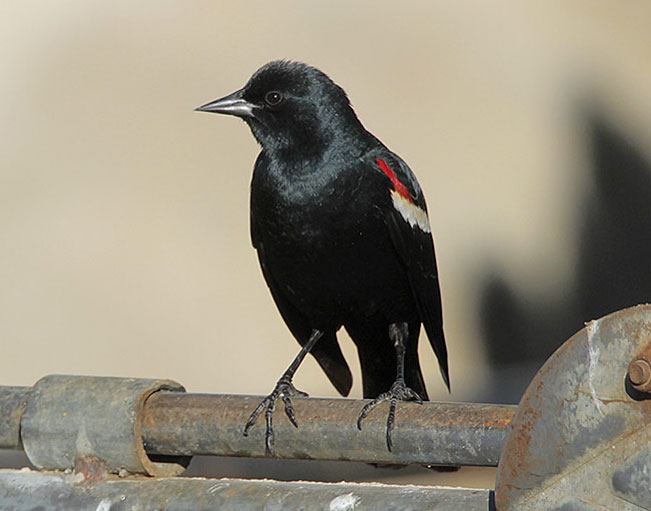
Scientific name: Agelaius tricolor
Size: 8.75 inches
Habitat: Freshwater marshes, grasslands, and other scrubby and open habitats.
Tricolored Blackbirds look a lot like Red-winged Blackbirds. However, with a close look, we can see that males have black plumage with a buffy or white and red shoulder. The streaked females look even more like female Red-winged Blackbirds but are more dark gray than gray and brown with some red-brown highlights.
It’s also easy to identify female Tricolored Blackbirds because they usually occur with their male counterparts. We usually see this species in large flocks that forage in farm fields and wetlands.
Although some Tricolored Blackbirds live in eastern Oregon and Washington, this endangered bird mostly lives in California.
Red-winged Blackbird
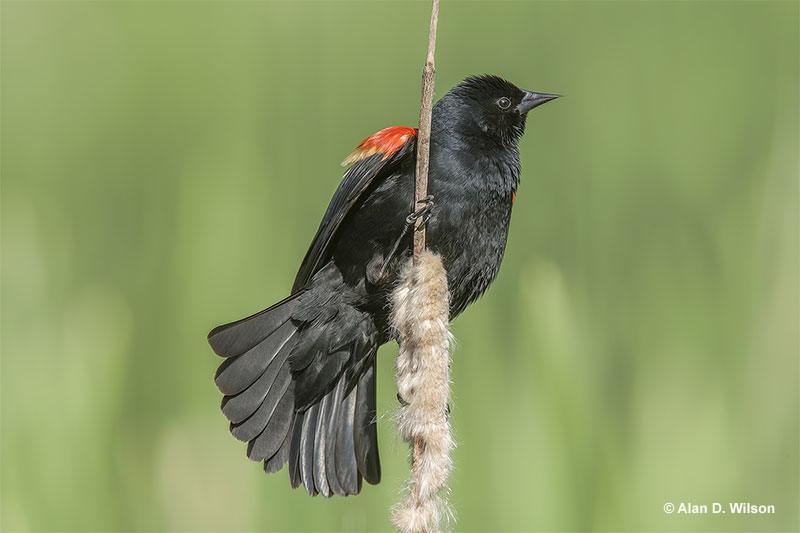
Scientific name: Agelaius phoeniceus
Size: 8.75 inches
Habitat: Marshes, brushy fields, parks with scattered trees and other similar habitats.
Red-winged Blackbirds are one of the most abundant bird species in North America. During migration and winter, flocks of Red-winged Blackbirds can number in the many thousands!
In spring, the “Kon-keree!” song of this pretty blackbird species is a common sound of brushy field, ditches, and wetlands.
Males have black plumage with right red and yellow shoulders while females are dark gray-brown with thick streaks and red-brown highlights. They usually occur together and are very social birds.
This familiar blackbird forages for insects and grain on the ground and in low vegetation. They are common, easy to see, and mostly occur in marshes, parks, and open fields.
Rusty Blackbird
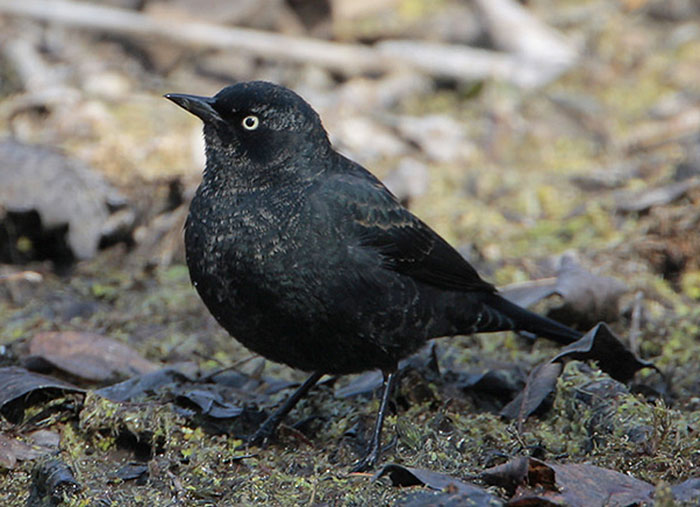
Scientific name: Euphagus carolinus
Size: 9 inches
Habitat: Forested swamps and woodlands.
Rusty Blackbirds are uncommon, pale-eyed blackbirds that breed in the far north. Unlike most other blackbirds in the USA, this species prefers woodlands and only occasionally come into the open.
After breeding in boreal bogs, flocks migrate to swampy woodlands in the eastern USA. In breeding plumage, male Rusty Blackbirds are dull black while females are grayish with blackish wings and tail.
In non-breeding plumage, both sexes have red-brown or rusty highlights; a good field mark for identifying them. Sadly, habitat loss has caused the Rusty Blackbird to become listed as “Vulnerable”.
This species forages for insects and seeds on the ground and can also visit feeders.
Brewer’s Blackbird
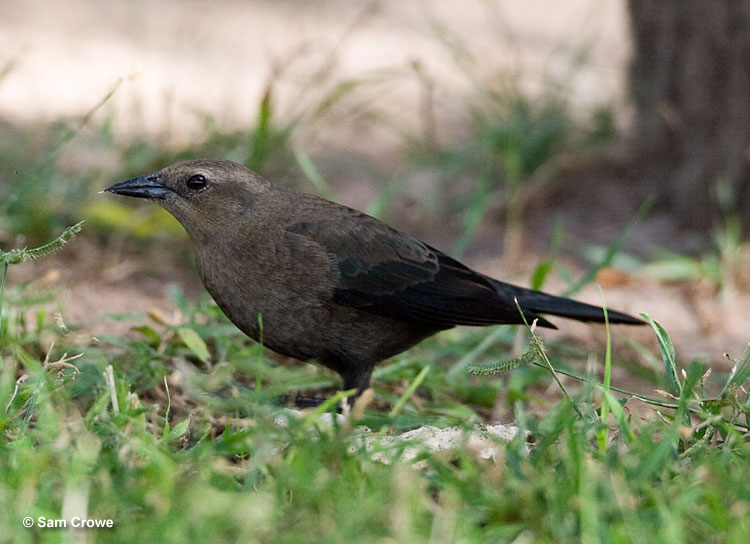
Scientific name: Euphagus cyanocephalus
Size: 9 inches
Habitat: Grasslands, parks, and other open habitats.
Brewer’s Blackbirds are one of the most familiar and common blackbird species in the western states. Males are glossy black with pale eyes while females are grayish with dark eyes and blackish wings and tails.
They can look a lot like a Rusty Blackbird but the Brewer’s Blackbird doesn’t have red-brown plumage. This species also has a slightly shorter beak.
Flocks of Brewer’s Blackbirds like to forage for insects and other bits of food on lawns, parks, and other open habitats with short grass. In winter, they can also form huge flocks that mix with grackles and other blackbird species.
Bobolink
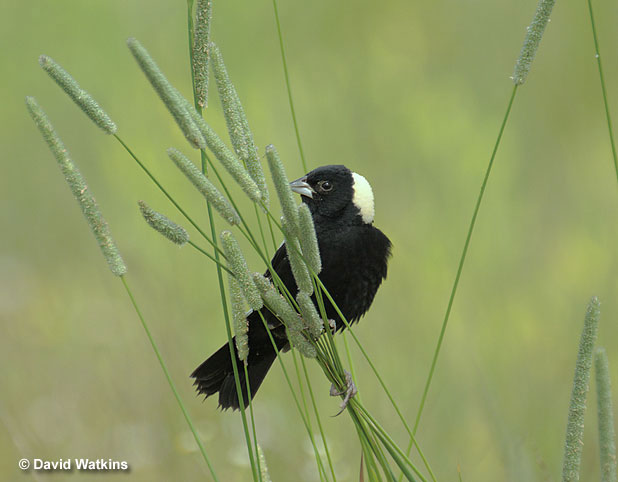
Scientific name: Dolichonyx orizyvorus
Size: 7 inches
Habitat: Tall grass prairies, hay fields, and other grassy habitats.
Bobolinks are smallish, finch-like blackbirds that breed in northern grassland habitats. Breeding males are smart looking birds with black plumage, a pale golden nape, and silvery highlights on their back, rump, and wings.
Female Bobolinks and non-breeding males are straw-colored, sparrow-like birds with a dark crown, pinkish beak, and streaks on their backs and sides.
In summer, males sing a robotic, complex song. They sing from a tall stalk, or in flight high above the grass.
After breeding, flocks of these pretty little blackbirds migrate to rice fields, grasslands, and wetlands from Bolivia to northern Argentina! In general, Bobolinks are common and pretty easy to see.
Western Meadowlark
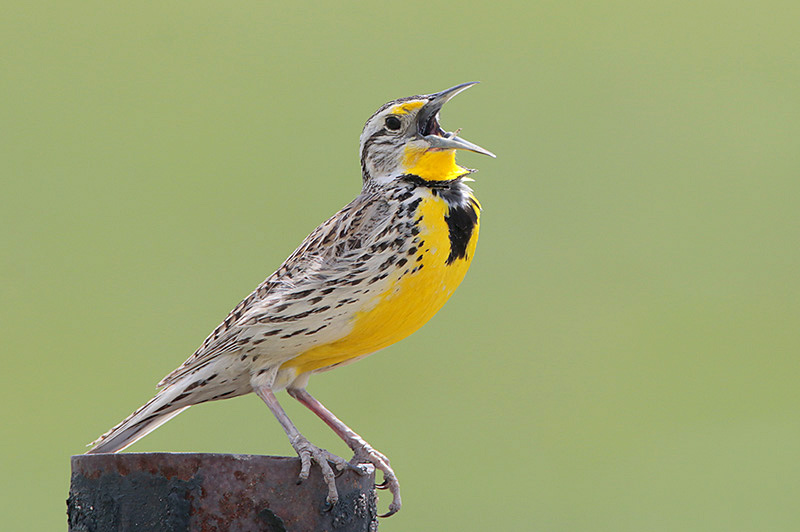
Scientific name: Sturnella neglecta
Size: 9.5 inches
Habitat: A variety of open arid habitats.
Western Meadowlarks are rotund blackbirds with streaked, pale brown upperparts, and bright yellow underparts. They also have some black marks on white flanks and a prominent black “V” on their chest.
Both sexes look the same and forage for insects and seeds on the ground. They prefer open areas with sparse grass, and are pretty easy to see, especially when males sing their pretty song.
Western Meadowlarks have a song that starts with a couple clear whistles followed by brief warbling notes. This pleasant bird song is a classic sound of western lands and can often be heard in movies and television shows!
Eastern Meadowlark
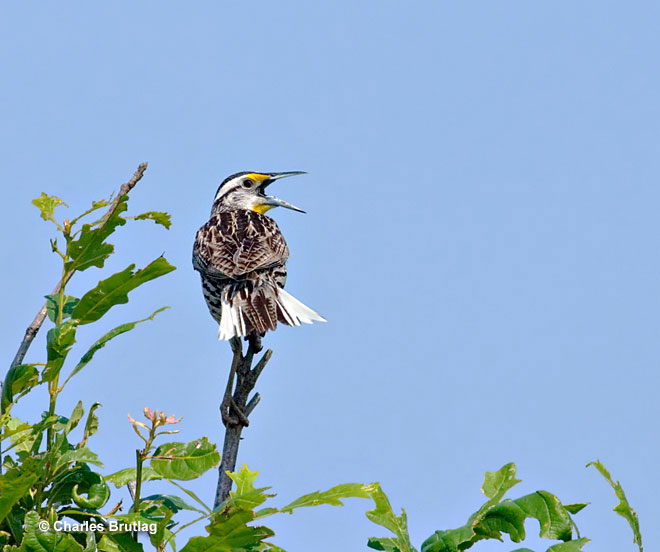
Scientific name: Sturnella magna
Size: 9.5 inches
Habitat: Grassland habitats.
Eastern Meadowlarks are stocky blackbirds with streaked, pale brown upperparts, and a long sharp beak. They are also bright yellow below with a black “V” mark on their chest, and have some dark marks on their white sides.
In flight, like other meadowlark species in the USA, Eastern Meadowlarks also show a lot of white in their tails. We find this pretty blackbird species in pastures and other grassland habitats where they forage on the ground for bugs and seeds.
Eastern Meadowlarks also look a lot like Western and Chihuahuan Meadowlarks but usually live in wetter areas and have a simpler, flute-like song.
Chihuahuan Meadowlark
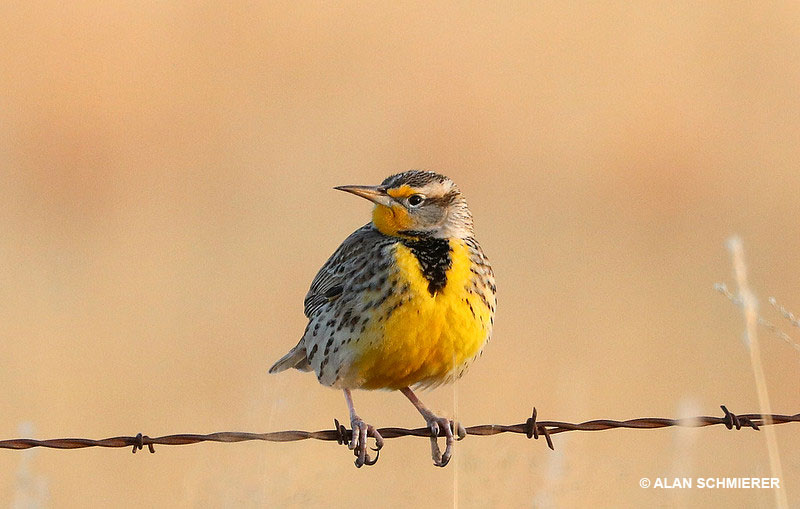
Scientific name: Sturnella lilianae
Size: 9.5 inches
Habitat: Desert grasslands.
Chihuahuan Meadowlarks are the third meadowlark species in the USA. You won’t find this bird in older field guides but might see mentions of the “Lilian’s Meadowlark”. At some point, this meadowlark subspecies was given full species status and named the “Chihuahuan Meadowlark”.
It looks a lot like the other meadowlarks but is noticeably paler, has more white in the tail, and spots on its sides instead of streaks. Chihuahuan Meadowlarks also sing a whistled song and sound more like an Eastern Meadowlark than a Western Meadowlark.
Luckily, the Chihuahuan doesn’t live near the Eastern Meadowlark. It only occurs in arid grasslands in the southwestern states.
Shiny Cowbird
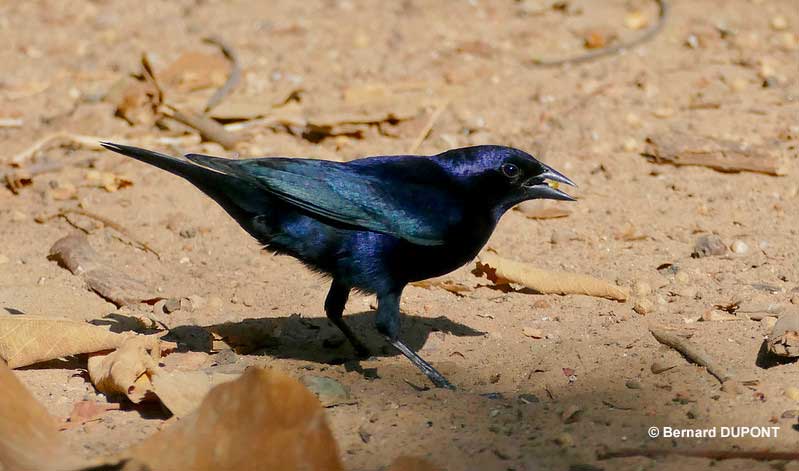
Scientific name: Molothrus bonariensis
Size: 7.5 inches
Habitat: Farms, parks, and other semi-open habitats.
Shiny Cowbirds are slender blackbirds with a longish tail, black eyes, and a rather slender, finch-like beak. Males are completely iridescent black while females are grayish with a black beak and a hint of a pale eyebrow.
This species mostly occurs in South America but has recently spread to the USA. Although we mostly see it in Florida, it can turn up in various other places.
Like other cowbirds, Shiny Cowbirds are nest parasites that let other bird species raise their young. They can lay their eggs in all sorts of nests and occur in parks, suburban yards and similar habitats.
Bronzed Cowbird
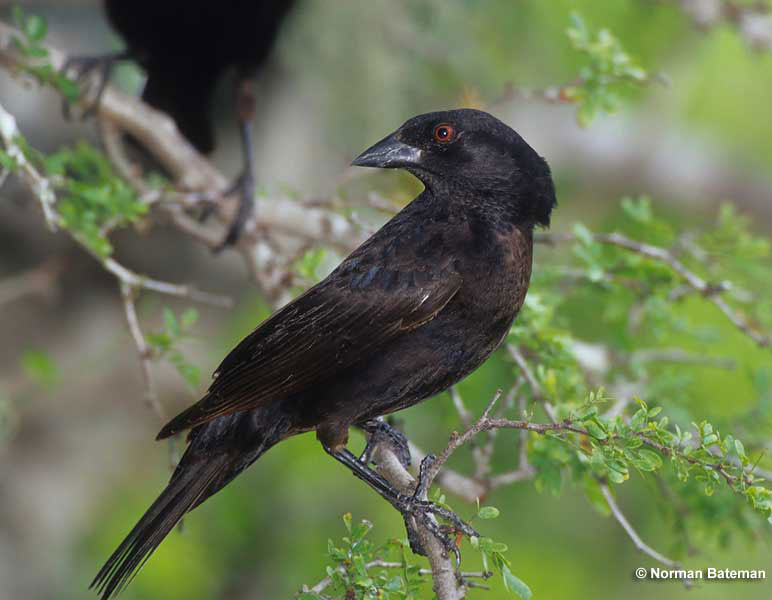
Scientific name: Molothrus aeneus
Size: 8.75 inches
Habitat: Farms and other open habitats.
Bronzed Cowbirds are smallish blackbirds with reddish eyes and finch-like beaks. Males are iridescent black with dark shiny blue on their wings. Females are similar but are duller black or grayish with dark wings and tail.
Male Bronzed Cowbirds also have a neck ruff that they spread during their courtship displays!
This cowbird species occurs in flocks, especially around cattle and near water in arid areas. It only just crosses the border and mostly lives in Mexico and Central America.
Even so, Bronzed Cowbirds like open habitats and are pretty easy to see within their limited range in the USA.
Brown-headed Cowbird
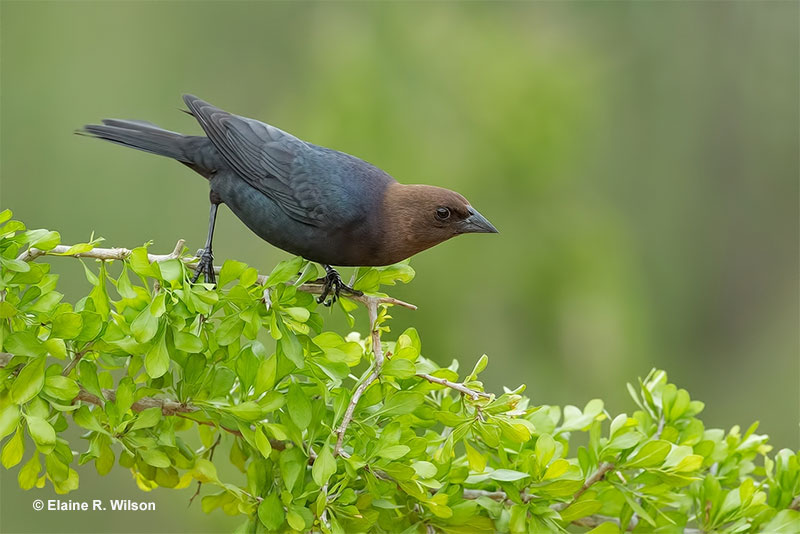
Scientific name: Molothrus ater
Size: 7.5 inches
Habitat: Farms, parks, and many other open and semi-open habitats.
Brown-headed Cowbirds are smallish blackbirds with short, finch-like beaks. With their brown heads and iridescent black bodies, male Brown-headed Cowbirds are pretty easy to recognize. However, females can throw birders for a loop!
We can recognize them by their grayish plumage with some blurry streaks, pale throat, and finch-like beak.
True to their name, Brown-headed Cowbirds are often seen near cows. However, we can also see flocks in parks and all sorts of open and semi-open habitats.
This species is a nest parasite that has become very common. In some areas, they are even trapped and euthanized to protect rare nesting warblers and the Black-capped Vireo.
Common Grackle
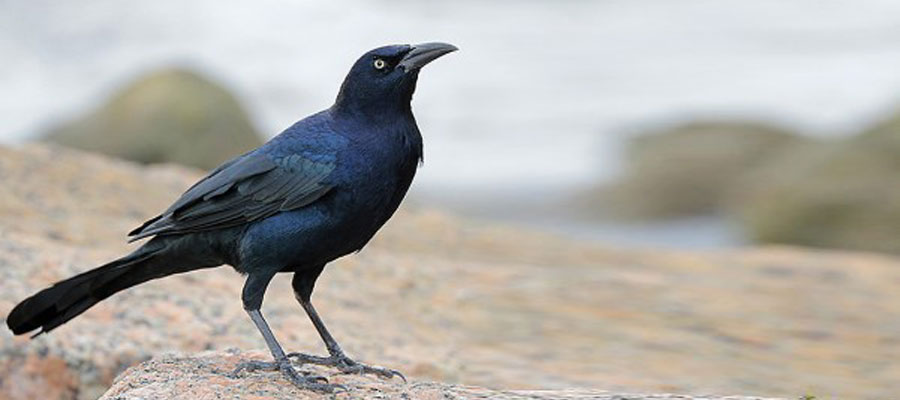
Scientific name: Quiscalus quiscula
Size: 12.5 inches
Habitat: Parks, farms, suburban areas, and other semi-open habitats.
Common Grackles are good-sized blackbirds that are hard to miss. These bold birds forage for insects and other bits of food on lawns and other open areas. They can also visit feeders and announce their presence with their loud metallic song.
Males have iridescent black plumage, a strong, sharp beak, pale eyes, and long, wedge-shaped tails. Females look the same but are duller and have shorter tails.
During migration and winter, Common Grackles can form big flocks that forage in farm fields. Although they are still easy to see, Common Grackles are Near Threatened! They have probably declined from changes to their habitat and heavy pesticide use.
Boat-tailed Grackle
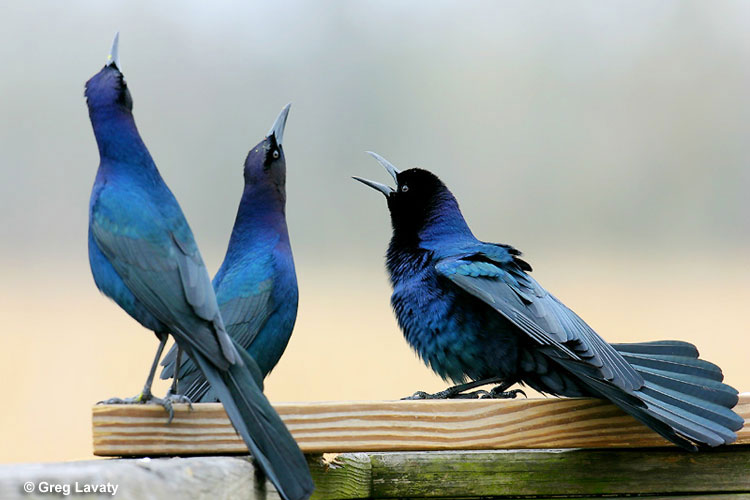
Scientific name: Quiscalus major
Size: 14.5 to 23 inches
Habitat: Saltwater marshes, parks, and urban areas near wetlands.
Boat-tailed Grackles are big, long-tailed blackbirds of Florida and coastal salt marshes. Males are iridescent black with pale eyes, a long, strong beak, and a very long, rounded tail. Females are brown with blackish wings and tail and some pale markings on their head.
Within their range, these bold blackbirds are easy to see as they call from bushes and forage on the ground. Although they look a lot like Great-tailed Grackles, that species has a more wedge-shaped tail and less rounded head.
We usually see Boat-tailed Grackles in pairs but in some areas, they can form large noisy flocks!
Great-tailed Grackle
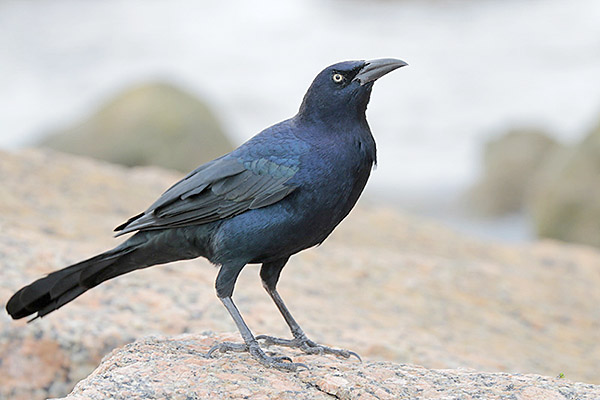
Photograph © Greg Lavaty.
Scientific name: Quiscalus mexicanus
Size: 15 to 23 inches
Habitat: Parks, farms, urban areas, and other open habitats.
Great-tailed Grackles are big, bold blackbirds that benefit from living near people. Males are large black birds with iridescent plumage and a long, wedge-shaped tail. They also have pale eyes and a strong, sharp beak.
Females are smaller birds with grayish plumage, dark wings and tail, a pale throat, and pale eyebrows.
This species often forages for insects and other bits of food in pairs and small flocks. They walk on open ground, streets, and other open habitats, and are very adapted to living with people. In many places, large numbers of noisy Great-tailed Grackles also roost in urban parks!
Audubon’s Oriole
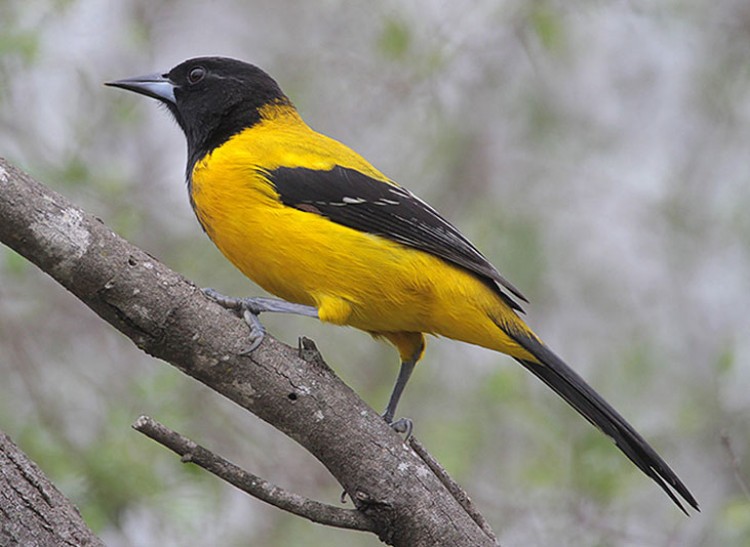
Scientific name: Icterus gradaucauda
Size: 9.5 inches
Habitat: Riparian forest and other subtropical woodland habitats.
The Audubon’s Oriole is a handsome, yellow oriole with a black head, and greenish back. Both sexes look the same and also have a long, rounded black tail, and one narrow white bar on their black wings.
The combination of black head, yellow plumage and greenish-yellow back easily separates them from other oriole species in the USA. We also only find Audubon’s Orioles in subtropical woodlands of southernmost Texas.
In that area, these pretty birds can come to fruit and nectar feeders but we usually see pairs foraging in natural subtropical vegetation. One way to find an Audubon’s Oriole is by listening for its slow, “lazy” whistled song.
Altamira Oriole
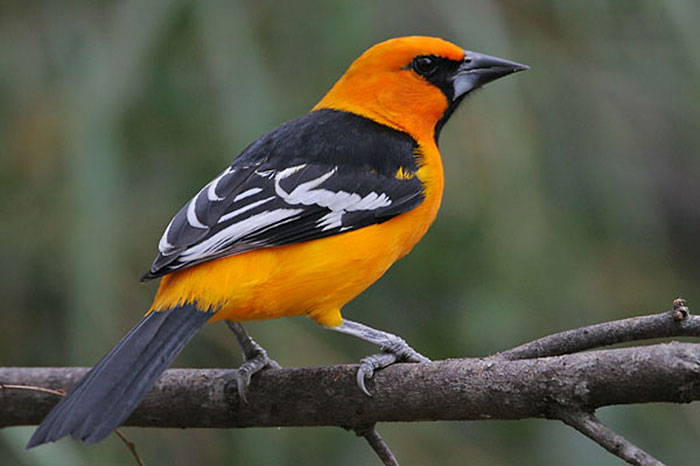
Scientific name: Icterus gularis
Size: 10 inches
Habitat: Subtropical woodland habitats.
Altamira Orioles are big, bold, orange and black orioles of southern Texas. These handsome birds are deep orange with a bit of black on their face and a black throat. They also have a black back, tail, and a stout, sharp black beak with a bit of gray on its base.
Another thing to look for on Altamira Orioles is orange shoulders on black wings with one white wing bar. This species usually occurs in pairs that forage for nectar, fruit, and insects in subtropical woodlands and scattered trees.
Thankfully, it’s not too tough to see, especially when you hear their loud chattering calls!
Bullock’s Oriole
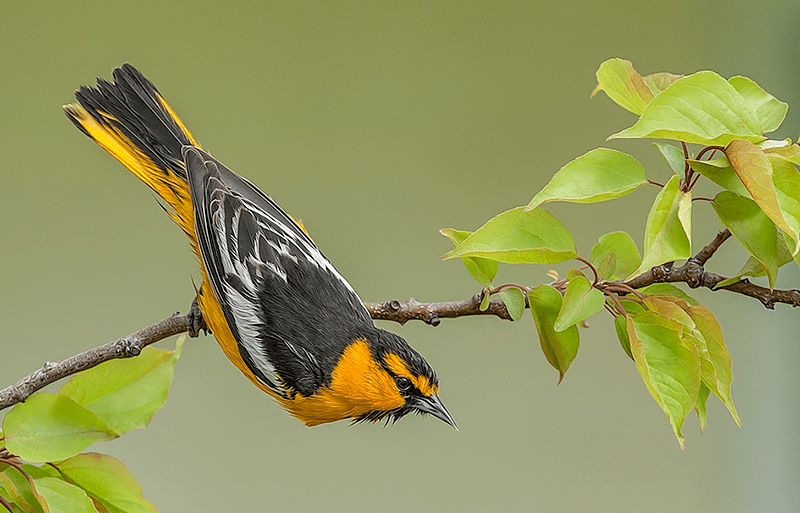
Photograph © Alan Wilson.
Scientific name: Icterus bullockii
Size: 9 inches
Habitat: Open woodlands and riparian zones with lots of cottonwoods and other big trees.
The Bullock’s Oriole is the common oriole species of the western USA. It essentially replaces the Baltimore Oriole west of the Rocky Mountains and is a typical bird of riparian zones and all sorts of woodland habitats.
Oddly enough, despite major plumage and vocal differences, this pretty bird used to be considered the same as the Baltimore Oriole! They have since been separated into distinct species and male Bullock’s are easily recognized by their narrow black throat, black line through their eyes, and lots of white in their wings.
Females are tougher to identify but are pale gray with a pale yellow tail, head, and throat.
Baltimore Oriole
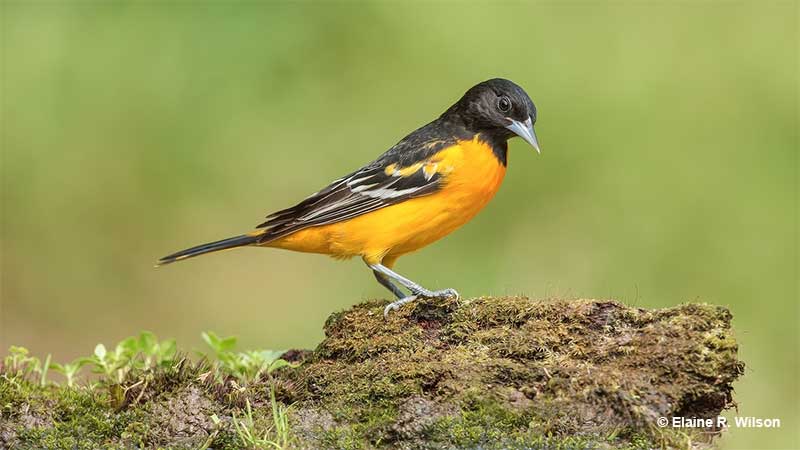
Scientific name: Icterus galbula
Size: 8.75 inches
Habitat: Various deciduous woodland habitats.
Baltimore Orioles are the common orange and black oriole of much of the eastern USA. Males are beautiful orange birds with a black hood, black and white wings, and an orange and black tail.
Females can be tricker but are basically orangish birds with a sharp beak, and two pale wing bars.
We find this familiar species in a variety of woodland habitats where they forage for nectar, insects, and berries. Put out a nectar feeder and some orange slices and this pretty bird could visit for close views!
Like other orioles, Baltimore Orioles construct distinctive, woven hanging nests.
Hooded Oriole
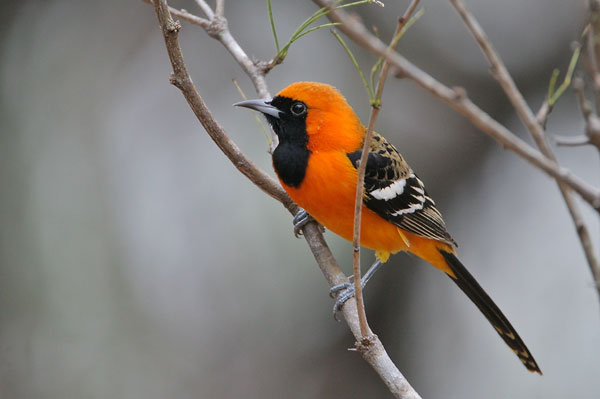
Scientific name: Icterus cucullatus
Size: 8 inches
Habitat: Areas with scattered trees and palms, parks and backyards, and riparian zones.
Hooded Orioles are beautiful, slender, orange and black orioles with long, rounded tails, and a sharp, pointed beak. Males are orange with black on their face and throat. They also have a black back and tail, and black wings with a white shoulder and narrow white wing bar.
Female Hooded Orioles are grayish with dingy yellow on their heads, underparts, and tail, and have two pale wing bars.
We usually see pairs of this pretty bird foraging for nectar and insects in flowering trees and other vegetation. This beautiful oriole species likes arid or subtropical areas with scattered trees and often nests in parks and backyards.
Orchard Oriole
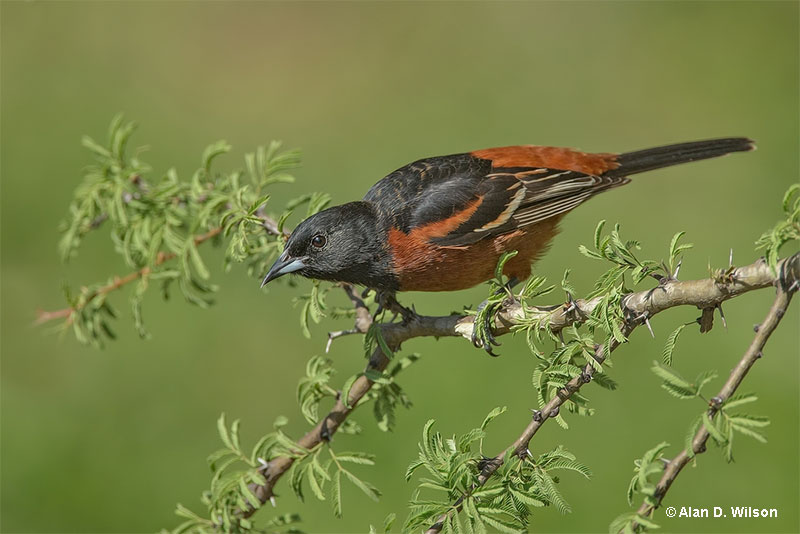
Scientific name: Icterus spurius
Size: 7.25 inches
Habitat: Open woodland habitats with brushy fields.
Orchard Orioles are the smallest type of oriole. In fact, the first time you see one, you might even wonder if you are seeing some kind of warbler. It’s Ok, that happens to all of us!
Male Orchard Orioles are handsome chestnut birds with a black head, back, and rounded tail. They also have chestnut shoulders and some white in their wings.
We see pairs and small flocks of these pretty birds in flowering bushes and trees, especially in brushy areas with scattered trees. They often give harsh brief calls as they forage for nectar and insects.
Scott’s Oriole
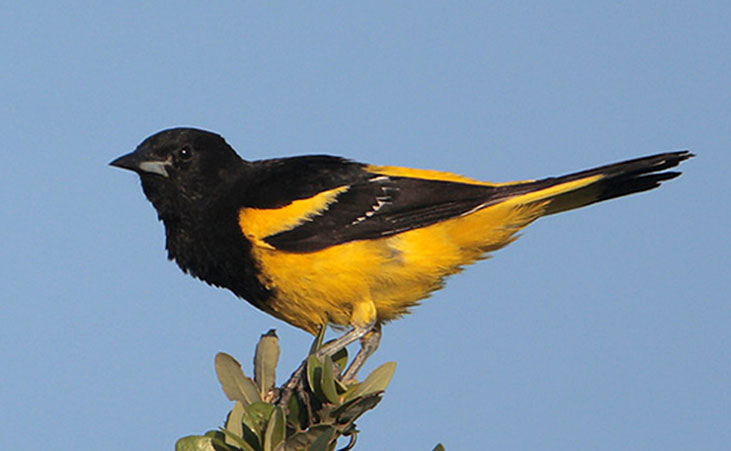
Scientific name: Icterus parisorum
Size: 9 inches
Habitat: Arid grasslands and arid brushy habitats, often in hilly areas.
The Scott’s Oriole is a beautiful yellow and black oriole of arid grassland habitats. Since the male is the only yellow oriole with a black head, back, and chest, this beauty is pretty easy to identify.
Scott’s Orioles also have white markings in their black wings, yellow and white shoulders, and a black and yellow tail. Females look like a dingy, washed out version of their male counterpart.
This pretty oriole species usually occurs in pairs that forage for nectar and insects in flowering yucca, cactus, and other brushy vegetation. It seems especially tied to yucca plants. Find those and you should see a Scott’s Oriole!
Frequently Asked Questions
How many different blackbird species are there?
There are 106 blackbird species. This includes the orioles, grackles, meadowlarks, and the big oropendolas of Central and South America.
How many blackbird species live in the United States?
In total, 27 blackbird species live in the United States. However, four of those are rare vagrants and one, the Spot-breasted Oriole, is an introduced species.
Is the blackbird family related to crows?
Despite their appearance, the blackbird family is not related to crows in any way.
Are all blackbirds primarily black?
Not all blackbirds are primarily black. Orioles are blackbirds that have orange and yellow in their plumage and meadowlarks are mostly pale brown and yellow.
Are orioles related to blackbirds?
Indeed, orioles are related to blackbirds. They are in the same family, the Icteridae.

